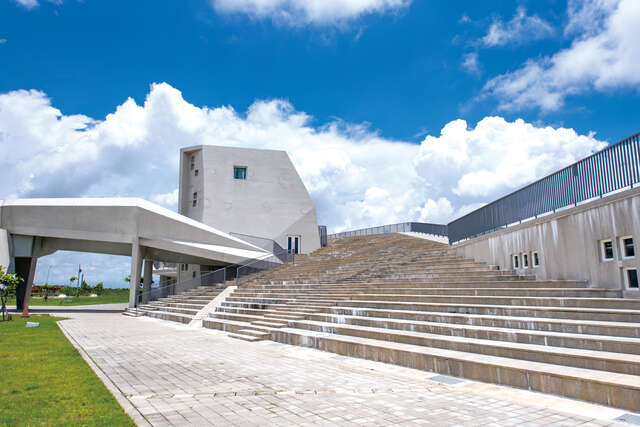Qigu Visitor Center Introduction
Due to tidal factors, the Sixth Island Trail is covered by water during high tide, making it impassable for visitors. To avoid the impact of tides on the visitor experience, you can check the tidal times at the Central Weather Bureau of the Ministry of Transportation. The main structure of the Sihku Visitor Center is based on the concept of a "dike," which is aimed at reducing the visual disconnection caused by human architecture on the natural environment. It incorporates local elements, such as sea dikes, river dikes, and salt dikes, as design elements, employing a folded plate system to transform "dike" into space, resembling stacks of salt blocks that take shape after being washed and collapsed by rainwater, steep as cliffs and sometimes gentle as slopes, where the shape of valleys can also be observed, embodying the power of nature's impact on the land. The main structure is dominated by a grayish-white color, shining brightly against the blue sky, giving this "dike" a varied appearance at different times of the day. The architectural structure creates the imagery of a salt mountain landscape in space, enhancing the compatibility of the building with the local scenery. This building symbolizes the unique natural landscape of the area and embodies the commitment to protect the marine environment while showcasing the beauty of the coastal area. As an information station connecting nearby attractions, the Sihku Visitor Center has become a new tourism landmark, providing a base for in-depth coastal tourism and offering friendly and diverse services to visitors. The charming Sixth Island, a floating hut, is not only a popular photo spot but also won the 2022 MUSE DESIGN AWARDS in the United States. The location of the "Sixth Island" coincidentally represents the sixth production area of the South Salt Region of Sihku during the Japanese colonial period, hence the name. The work is based on the development and changes of the salt industry in the Sihku Salt Fields, interpreting the mindset of residents who have experienced changes in the salt industry and the essence of salt workers, transforming it into a floating art installation of an island and a hut, while integrating the image of early salt field "salt windmills," conveying a sense of "silent beauty" in the space. Like the hut on an uninhabited island, it changes with different light and shadow variations throughout the day, while its "salt" color represents the natural elements of salt production: sunlight, seawater, and sea breeze. The work also intentionally creates serendipitous opportunities for "island landing," where the water level of the scenic pool fluctuates with the tides; when the water level covers the path, it will be closed to visitors, allowing them to enjoy the feeling of the secluded island hut from the shore or check the tidal table of Sihku before visiting. The environmental art installation at the Sihku Visitor Center - Sixth Island was designed by Professor Chen Yu-liang. Location: Landscape Pool of the Sihku Visitor Center.




































